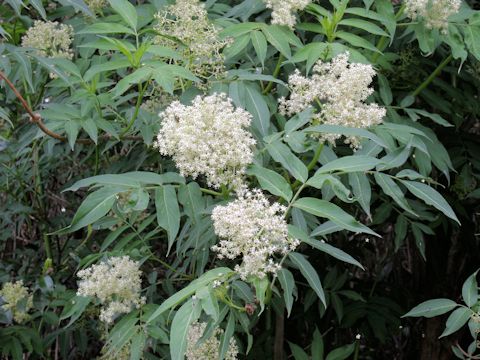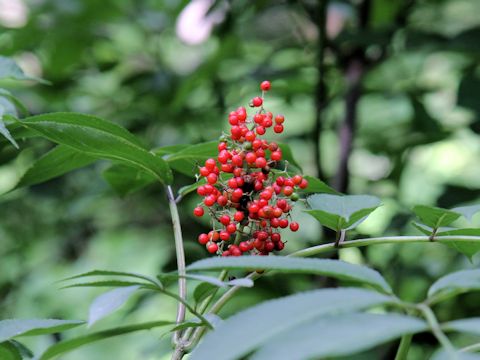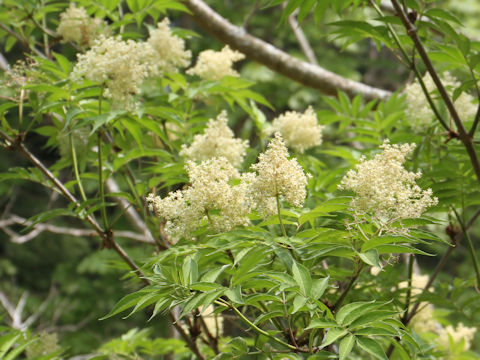
|
|
|
|
−− もっと見る(Show more)−−
−− 閉じる(Close) −−
|
|
|
|
わが国の本州から四国・九州、それに朝鮮半島に分布しています。山野の林縁に生え、高さは5メートルほどになります。葉は奇数羽状複葉で、4月から5月ごろ、円錐花序に淡黄白色の小さな花をたくさん咲かせます。果実は梅雨のころに暗赤色に熟します。和名は、鶏の止まり木として使ったことから。また別名の「せっこつぼく(接骨木)」は、小枝の黒焼きを骨折したときに湿布として用いたことに由来します。 |
|
|
スイカズラ科ニワトコ属の落葉低木で、学名は Sambucus racemosa ssp. sieboldiana (syn. Sambucus sieboldiana)。英名は Japanese elderberry。 |
|
|
The Japanese elderberry (Sambucus racemosa ssp. sieboldiana) belongs to Caprifoliaceae (the Honeysuckle family). It is a small deciduous tree that is distributed from Honshu, Shikoku and Kyushu of Japan, as well as the Korean Peninsula. This tree grows in outskirts of woods and can reach about 5 m in height. The leaves are imparipinnate. The numerous pale yellowish white flowers come in the panicles from April to May. The fruits ripen dark red in the Bai-u (rainy season). The burned ash of the twigs had been used for poulitices of fracture in Japan. The Japanese name "Niwa-toko" comes from its use as a perch for chickens. Another name in Japan, "Sekkotsu-boku" (grafted bone tree) comes from the fact that blackened twigs were used as a poultice for broken bones. |
|
|
[上・中1] 埼玉県さいたま市「田島ヶ原」にて、2010年04月11日撮影。 [中2〜3・中11] 岐阜県瑞浪市土岐町にて、2007年04月13日撮影。 [中4] 奈良県御所市関屋「金剛山」にて、2006年04月14日撮影。 [中5] 京都市左京区「京都府立植物園」にて、2006年03月29日撮影。 [中6] 大阪府四條畷市「むろいけ園地」にて、2006年04月16日撮影。 [中7] 大阪府交野市「大阪市大付属植物園」にて、2007年03月10日撮影。 [中8] 大阪府河内長野市「花の文化園」にて、2006年11月21日撮影。 [中9・中10] 長野県塩尻市旧塩尻にて、2007年07月11日撮影。 [中12] 千葉県香取市阿玉川にて、2009年06月03日撮影。 [中13・中14] 群馬県沼田市利根町にて、2010年06月27日撮影。 [中15] 群馬県高崎市「観音山」にて、2012年04月01日撮影。 [中16・中17] 千葉県香取市大角にて、2012年04月30日撮影。 [中18] 福島県磐梯町「おおるり公園」にて、2012年06月22日撮影。 [中19・中20] 福島県いわき市「往生山」にて、2014年04月20日撮影。 [中21・中22] 山形県小国町「温身平」にて、2017年06月03日撮影。 [中23〜中25] 福島県会津若松市東山町「背炙り山」にて、2020年03月21日撮影。 [中26・中27] 宮城県山元町山寺「深山」にて、2020年05月01日撮影。 [中28〜29・下] 宮城県加美町「薬莱山」にて、2023年04月27日撮影。 |

|
|
Shu Suehiro |






























